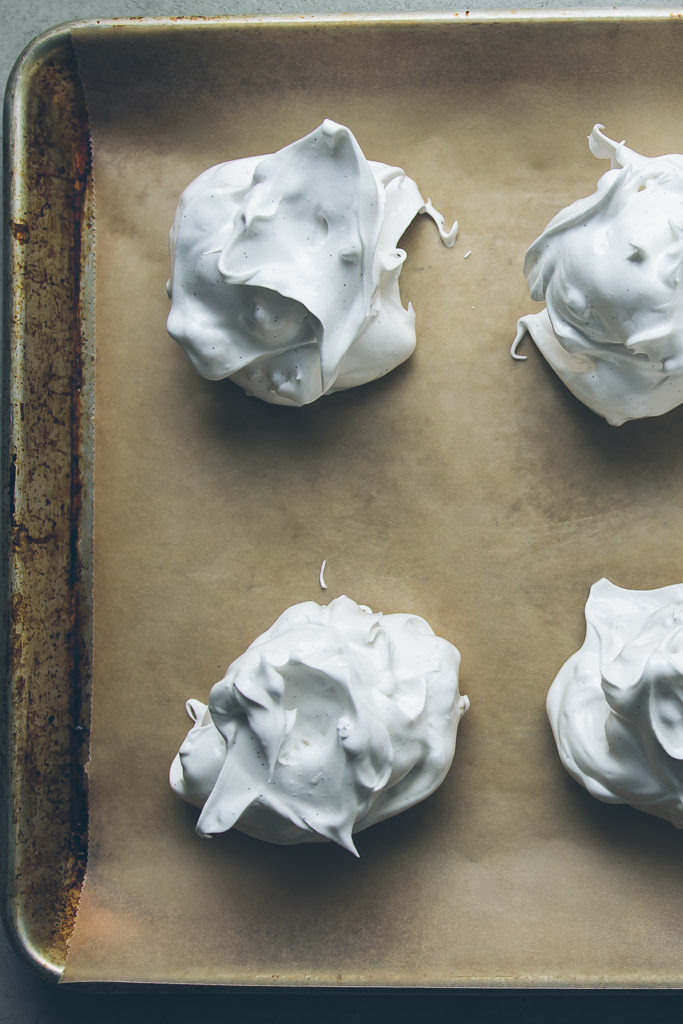I am not a baker at heart. I like to improvise as I’m cooking and don’t have the love of precision and order that all great pastry chefs have. But over the years, I’ve come to appreciate the art and science of pastry-making (especially the science part) and now consider myself a tolerably good baker. I can make a very solid pie crust. I understand what makes a cookie crisp versus chewy. I can temper chocolate well enough to make all sorts of bark at the holidays.
My white whale, however, has always been meringue.
I am not easily intimidated in the kitchen and will give almost any culinary effort my best shot. But I have had some really disastrous run-ins with meringue. There was one year I made hundreds upon hundreds of Alice Medrich’s Peanut Butter Clouds for a Homemade Holiday Gifts class I was teaching. These are a very basic meringue cookie, flavored with peanut butter and topped with toasted sesame. They taste AMAZING. The only problem is that if you don’t really know how meringue works, some of your clouds will come out looking gorgeous and fluffy and very, well, cloud-like, and some of your clouds will end up looking like a blob of marshmallow fluff somebody spilled on the floor. I ended up eating a lot of rejected Peanut Butter Clouds and having to make many extra batches to compensate. Not fun.
Then there was the Grand Marnier soufflé with salted caramel I became obsessed with after a trip to Paris. I spent hour upon hour in the kitchen trying to perfect a fail-safe soufflé base I could teach in a cooking class and never felt my recipe was 100% beyond reproach.
The tipping point came last December when I was working on a recipe for dark chocolate chestnut meringues to give as Christmas gifts. The flavor was fantastic: rich, dark chocolate melding with earthy-sweet chestnut. All that deliciousness clearly deserved to be enshrined in a perfectly-crisp-on-the-outside, meltingly-fluffy-on-the-inside meringue. And it was not happening. At all. Some of my efforts came out of the oven as gorgeous as I’d hoped. Others slumped and spread into sad puddles.
It was clearly time to step up my meringue game. So I delved into the science. I read everything I could find about egg whites and the mysterious alchemy of a successful meringue. I learned a lot. (For all you meringue-lovers and food-science geeks, you’ll find my definitive list of tips for working with egg whites below.) And I'm happy to say that after my research, those meringues turned out to be some of the most beautiful I'd ever made.
If you’ve ever been intimidated by meringue, allow me to help you conquer your egg white anxiety with these Pine Nut Meringues. The combination of sweet meringue and toasty pine nuts reminds me of my favorite French nougat. They’re delicious as-is, barely cool, right off the baking sheet, and spectacular topped with a mound of whipped cream and a swirl of summer berry compote. Either way, you can’t go wrong.
Read on and you’ll be coaxing a few egg whites and some sugar into ethereal mounds of fluff in no time. If I, impatient, improvisational cook that I am, can learn to make a glorious meringue, you undoubtedly can, too.
How to Work Magic with Egg Whites and Sugar
Fat is the enemy. A little fat left in a bowl or on your hands, can wreak havoc on your meringue. Make sure everything (your bowls, beater, hands) is clean, clean, CLEAN. Also, use the three bowl method of separating your eggs to make sure no yolks get into your whites.
Start with room temperature eggs. It's easier for the sugar to dissolve into room temperature eggs. If all you have is cold eggs, beat them at a low speed for a minute or two to warm them up.
Eggs are easier to separate when they're cold. I recommend separating your whites then covering them with plastic wrap and setting them aside to warm up.
Fresh eggs have a more acidic pH and a tighter protein structure, which leads to a more stable meringue. Older eggs will work, too, but if you have a choice, fresher is better.
The small granules of superfine sugar mean they dissolve into your egg whites more quickly and evenly. I sometimes cheat and use a high-quality granulated white sugar, but I never use my regular unbleached cane sugar for meringues.
How and when you add the sugar to your eggs is very important. If you add the sugar too early, the protein matrix that gives your meringue structure can't form properly. If you add it too late, the sugar won't dissolve completely and your meringues will be gritty. The key is to start adding the sugar right after the whites come to very soft peaks and to add it slowly. It should take about a minute to incorporate the sugar into the eggs. Don't rush it.
You can further stabilize your meringue with acid. In this recipe we're using vinegar, but you can use cream of tartar (tartaric acid) or even lemon juice.
A little cornstarch goes one step further in stabilizing your meringue and making sure it doesn't weep in the oven.
I couldn't find any hard science on this one, but kitchen wisdom dictates you not attempt meringue on a rainy or especially humid day. The air you whip into your whites will be heavy with water and won't whip up as light and fluffy.
Pine Nut Meringue Pavlovas
- 9 oz superfine sugar (about 1 cup plus 2 tablespoons)
- 1/2 vanilla bean
- 1 1/2 tablespoons cornstarch
- Pinch salt
- 6 oz egg whites (from about 5 large eggs), room temperature
- 2 teaspoons white wine vinegar
- 3/4 cup pine nuts, toasted and cooled
- 1 ½ cups cream
- 1 recipe blackberry compote (see below), cooled to room temperature
Place a rack in the middle of the oven and preheat to 250° F. Line a rimmed sheet pan with parchment paper.
Place the sugar in a small bowl. Split the half vanilla bean lengthwise and scrape out the seeds with a paring knife. Add the vanilla seeds to the bowl with the sugar. Using your fingers, rub the seeds into the sugar; this will keep the vanilla from clumping together in the meringues. Add the cornstarch and salt. Whisk to combine and break up any clumps.
Using a stand mixer fitted with the whisk attachment, whip the egg whites at medium speed until soft peaks form, 2-3 minutes.
Increase the speed a little and slowly sprinkle in the sugar mixture. It should take you about a minute; adding the sugar too quickly or before the eggs form soft peaks will result in a less stable meringue that might spread or weep. A minute or so after all of the sugar mixture has been added, add the vinegar. Increase the speed to medium-high and continue to whip until the meringue forms very stiff peaks, 5-8 minutes longer. You will know the meringue is stiff enough when it will hold the whisk attachment perfectly upright with no other support. Gently fold in the pine nuts.
Spoon the meringue into 6 heaping mounds, each about 4 inches wide on the parchment-lined sheet pan (be sure they aren’t touching). If you're making the meringues for pavlovas, use the back of a spoon to make an indentation in the middle of each meringue for the filling.
Bake the meringues until they are crisp and dry to the touch on the outside but still white (not golden or cracked), about 80 minutes. Check on the meringues periodically to make sure they aren’t coloring or cracking. If they are, rotate the sheet pan and reduce the oven temperature by 25 degrees.
When the meringues are done, let them cool for about 5 minutes on the sheet pan then carefully lift them from the parchment and place them on a wire rack to finish cooling. The meringues will keep, tightly sealed for up to a week if you have baked them fairly dry.
While the meringues are cooling, whip the cream to soft peaks. You can add a little sugar if you want, but keep in mind that the meringues are pretty sweet.
When the meringues are cool, serve topped with a generous amount of whipped cream and blackberry compote.
Makes 6 large meringues.
Blackberry Compote
10 ounces (approximately 1 pint) blackberries
3 tablespoons sugar, or to taste
2 tablespoons water, divided
Salt, to taste
1/2 teaspoon cornstarch
1 teaspoon lemon zest
Lemon juice, to taste
Place the blackberries, sugar, 1 tablespoon of water and a pinch salt in a small saucepan. Heat over medium-high heat until some of the berries burst and release their juices, about 5 minutes. You may need to smash some of the berries to coax them into releasing their juices. Remove the pan from the heat.
Place the cornstarch in a small bowl and add the remaining tablespoon of water. Stir to make a slurry and add it to the blackberry mixture. Cook for 1 minute more over medium-high heat. Remove the pan from the heat and stir in the lemon zest. Add lemon juice to taste; you may not need any if your berries are tart.
Can be eaten warm or cold.
Makes about 1 ½ cups.









